Collective and Augmented Intelligence Against COVID-19 – a decision support tool for policymakers
CAIAC is a platform designed to increase our common knowledge about the COVID-19 virus and give unique decision-making support. It dynamically maps knowledge about the virus and its impact by connecting localized initiatives and interventions.
Crisis and opportunity
In April 1959, President John F. Kennedy pointed out the relationship between danger and opportunity in the Chinese characters for crisis. Although the translation is closer to danger and incipient moment, the idea that a crisis can lead to opportunity and invention is something to hold on to during the difficult times that the COVID-19 crisis has brought up us. This is the perspective that my collaborators and myself have taken in our approach to the CAIAC initiative that I am presenting here.
Since the beginning of 2020, the world has watched the Johns Hopkins COVID-19 Dashboard spread from Wuhan to the rest of the planet with a morbid sense of panic. While facing their obvious lack of preparedness, governments turned to the scientific community for guidance on how to respond: surely there must be a silver bullet amongst all of these Artificial Intelligence systems being deployed around the world that could thwart the virus. Alas, there wasn’t.
The need for quick solutions to all of the problems related to COVID-19 has brought on a proliferation of datasets, dashboards, information portals and repositories from disparate sources that aim to provide front-line leaders with the critical information they need. Many were hoping to feed all this data into the AI systems so that they could in turn generate better faster, decisions.

Disappointingly, the volume of information and the lack of clear authority linked to data sources have been difficult to navigate, much less translate into actionable insights. What’s more, most information has remained fragmented and isolated, lacking the interconnectivity needed for mutual benefit and an overall view of what is available.
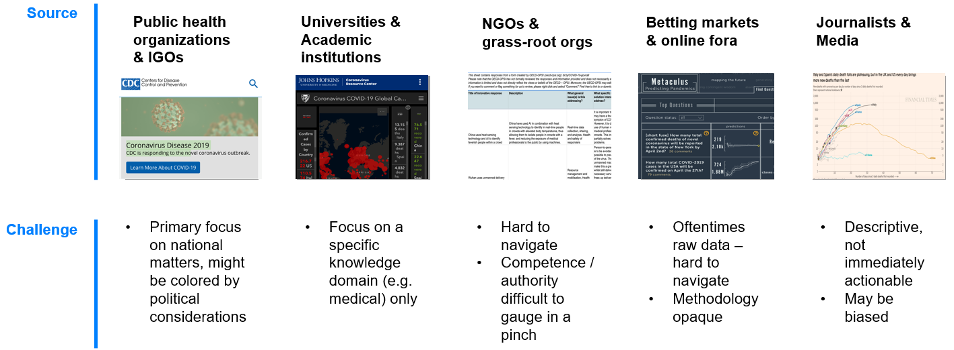
These very laudable efforts have been gathering data related to the growing pandemic and the field of healthcare, which makes perfect sense. However, it means that very little effort has gone into connecting and aggregating data to provide useful information and insights to combat the economic and social implications of COVID-19. CAIAC was born out of the need for policymakers to have a decision-making tool based on a truly universal and holistic approach.
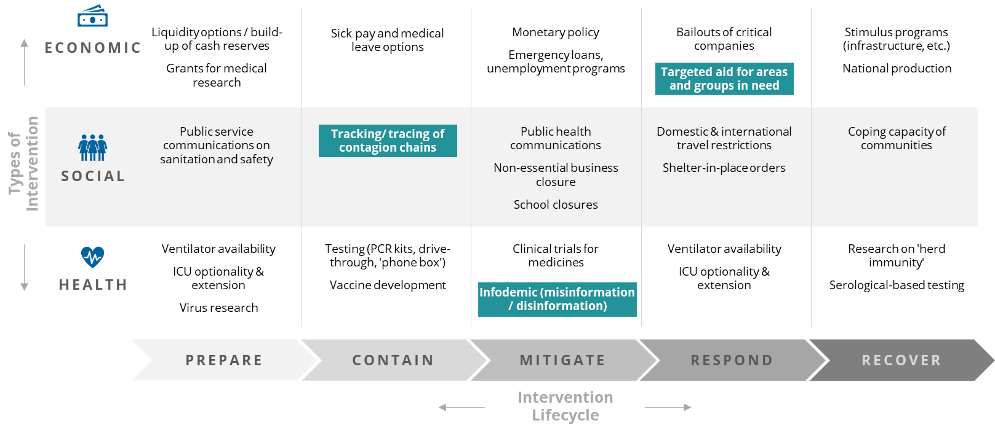
In launching CAIAC (pronounced kayak) we wanted to help policymakers navigate the ambient uncertainty brought on by the current crisis. At the same time, we wanted our solution to be a legacy tool to address future crises and pandemics.
A holistic approach across sectors, specializations and national borders
CAIAC asked what it would look like to bring together as many relevant stakeholders as possible, including the private sector, academia, foundations, civil society, international organizations and civil society. They would need to work together to provide the necessary thinking that would power this platform and help policy and decision-makers resolve the COVID-19 crisis.
So far, our ambitious challenge has been championed by a diverse and highly relevant group of AI actors: stability.ai – a GovTech US startup, Stanford Institute for Human-Centered Artificial Intelligence (HAI), the AI Initiative of The Future Society – a US 501(c)3, UNESCO – with the support of the Patrick J. McGovern Foundation and UN Global Pulse. Thanks to the UN’s involvement, CAIAC now benefits from close coordination with a growing number of UN partners (WHO, UNDP, World Bank, UNICRI…) as well as an increasing number of academic and technology partners worldwide.
Making data more exploitable
Partners at CAIAC know that while identifying data and information is relatively easy, there are many challenges to navigate it and make it exploitable. Our response to this challenge has been to create a dynamic, easy-to-use knowledge base and sense-making platform. The platform combines collective and augmented intelligence to structure the world’s information on COVID-19 and make it immediately useful for front-line policymakers, healthcare leaders, and other stakeholders.
Face masks: an example of comprehensive, authoritative, and up-to-date thinking
CAIAC’s usefulness is based on three pillars: being comprehensive, authoritative, and up-to-date. These qualities have been proven to lead to fundamental and positive advances in thinking and policy decisions. How the use of face masks developed during the COVID-19 pandemic is a good example of how this works.
At the onset of the pandemic, each new study about the benefits of wearing face masks seemed to contradict the last. Governments, citizens and even the scientific community were drowning in uncertainty. The scientific method was playing out in the public sphere for all to watch, but it was a systematic review, or a study of studies, that finally allowed everyone to confirm and accept the positive effects of mask-wearing and move on to the next phase.
Although somewhat imperfect, the systematic review was indeed comprehensive, authoritative, and up-to-date. It marked an inflection point worldwide, allowing a wide-ranging and timely review of the available evidence on public health measures to prevent the spread of COVID-19. It added to existing reviews, modeling, meta-analysis, and individual studies on the effectiveness of each of the main measures assessed (physical distancing, face masks and eye protection). It was enough for governments to recognize wearing masks is essential to slow the propagation of the virus.
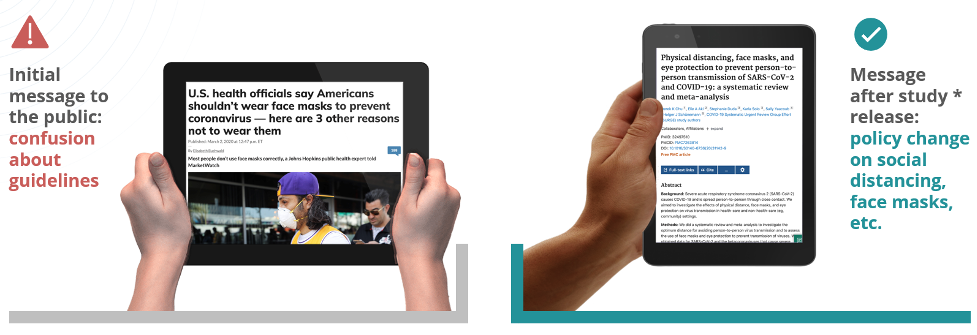
Once we saw how successful these pillars were in changing both public perception and policies, we understood that we needed to create specific use cases. We would also need to develop ontologies related to those cases, as during the pandemic knowledge expands so rapidly. Finally, we decided to go after knowledge and wisdom instead of targeting the vast lakes of data.
The CAIAC process and its scalability
The CAIAC process starts by conducting structured interviews with global experts for a specific use case. First, we identify and interview experts. Then, we transcribe their inputs and extract principles using Named Entity Recognition (NER). If the experts recommend any data sets or bodies of work, we add them to the system.
The platform is format agnostic, and can easily ingest different data sets and bodies of work. As we enter the structured interviews and bodies of work into the system, networks start to form. This allows AI tools to identify what is known and unknown, leading to potential blind spots.
This process gives a more accurate reflection of current scientific consensus rather than only what actually gets published. In fact, negative results are rarely published, which means that publications often lead to a loss of valuable knowledge. By targeting knowledge rather than data, the CAIAC process produces outcomes, evidence and recommendations that are more up to date than what is currently publicly available.
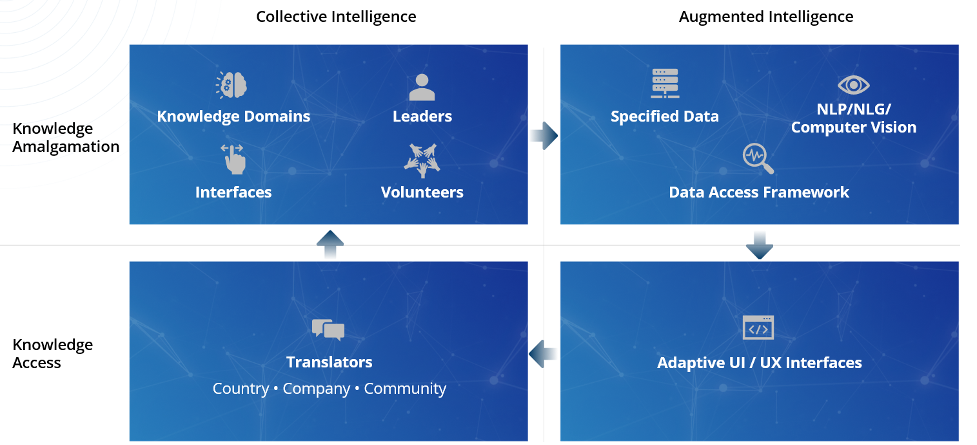
CAIAC’s methodology and principles make it a useful tool for tackling any multifaceted global crisis. Our ambition is to apply it to the 17 UN Sustainable Development Goals, and future global crises.

CAIAC ‘s comprehensive, authoritative, and up-to-date body of work also allows it to create multiple outputs for decision-makers. Policymakers can use knowledge graphs, query functions, or one of many customizable report generation features to make better decisions, faster.
Alignment with the OECD AI Principles
CAIAC follows an ethics-by-design approach, with research and development processes reflecting the OECD AI Principles. While we use them as our northern star, we also want to make sure these principles are being embedded at each stage of the process. By strictly adhering to the Principles, CAIAC is driven by tenets on societal and environmental well-being, human agency and oversight, transparency, technical safety, robustness and accountability.
CAIAC intends to hold itself accountable and optimize its performance concerning these values. Part of this is the self-assessment we developed to evaluate and optimize our alignment with the OECD AI Principles. Shortly, we plan to perform an algorithmic impact assessment and form an ethics committee to guide our adherence to these principles throughout CAIAC’s development, from its first functional prototype to large-scale adoption by governments and multilateral institutions.
Preliminary use cases
For the first iteration of the CAIAC platform, we have leveraged the expert network of our UN partners. This has allowed us to develop a robust research process that maps out common knowledge around the three initial COVID-19 related use cases: 1) tracking and tracing contagion chains via mobility data and AI, 2) addressing the “infodemic” of false information about COVID-19, and 3) targeting support for marginalized groups suffering second/third order pandemic impacts. So far, Hivemind, the software we use to synthesize and streamline data collection, has processed 1174 instances. To date, researchers have made 13,865 individual annotations on these use cases, based on a total of 530 web URLs and 146 PDFs.
Partnerships for more augmented intelligence
To iterate on the core knowledge base, we have begun integrating more augmented intelligence – enhancing the human worker – into the CAIAC process. This includes Natural Language Processing (NLP), Name Entity Recognition NER and press/research monitoring solutions from IRCAI, the UNESCO AI lab and Google. Discussions have been started with Microsoft, IBM, Salesforce Research, Intel and others for further support.
Next on our agenda, CAIAC plans to develop more use cases on the future of work, vaccine deployment and telemedicine. These projects should be held in coordination with governments and multilateral partners, such as the OECD, WHO and UNESCO. Currently, all of these areas have difficult dynamics that hinder timely decision-making. By providing a holistic picture (comprehensive, authoritative, up-to-date, and ethical), CAIAC will enable policymakers to make better decisions faster.
The following table summarizes the current situation and what CAIAC has made possible:
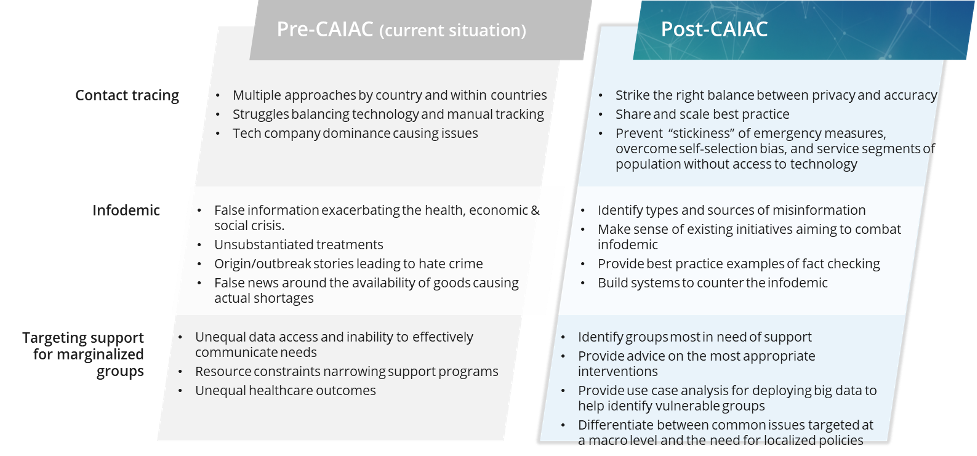
Where does CAIAC go from here?
With CAIAC up and running, it seems like the best way to improve it is to make it the subject of its own use case. A self-focused use case will analyze how each component works. It will look at how CAIAC engages with leading experts in areas such as NLP, complex systems design, collective intelligence, AI governance and decision support systems. With the appropriate checks and balances in place, this process will allow the CAIAC platform to rapidly evolve as it integrates more entities to help drive it forward.
While we have centralized control of CAIAC’s design and the initial platform construction, we will surely work with external solutions and partners on future versions. This process should remain as transparent and coherent as possible to ensure maximum uptake and impact.
Feedback and collaboration are always welcome. We are especially looking to augment all parts of the upcoming use cases pipeline, to better understand this pandemic and hopefully emerge from it stronger and better prepared for the challenges that lie ahead.
We are now focusing on completing the platform with a series of use cases that represent potentially relevant ontologies that currently do not exist.
Our close partnership with UN entities stems from our goal to make this crucial global and holistic knowledge platform accessible to the world’s governments. It is worth reiterating that beyond the pandemic, we designed this platform as a legacy system that will allow policymakers to rapidly leverage a powerful tool for any complex system or crisis that calls for efficient knowledge mapping and the fast dissemination of authoritative views.

































